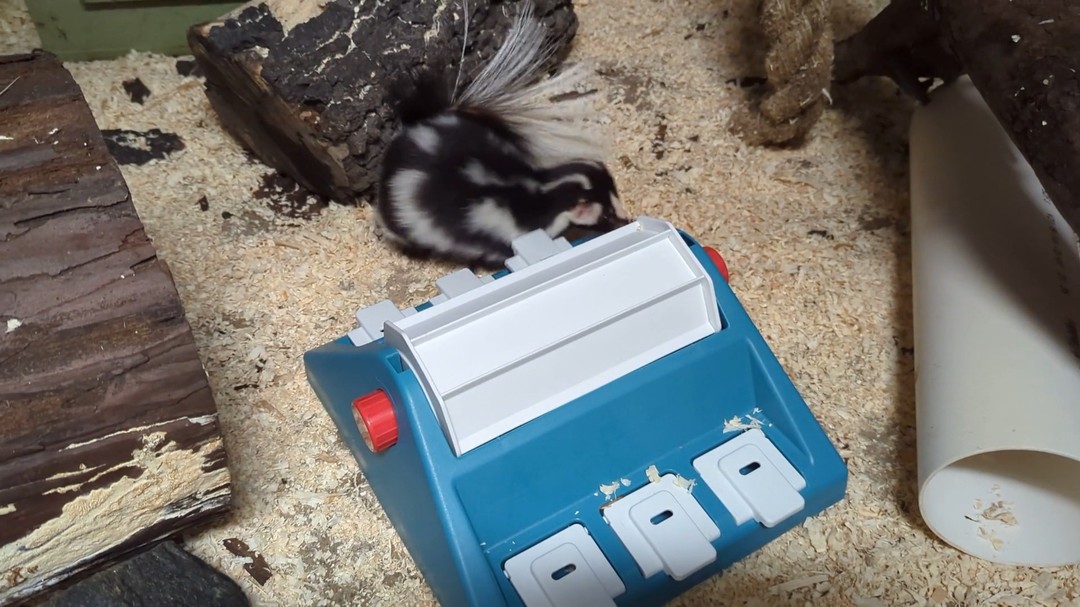- The Western spotted skunk’s behaviors and adaptations during the period of torpor when native wildlife generally reduces activity.
- The significance of environmental enrichment in zoo management to maintain the health and activity levels of animals like Boo the western spotted skunk.
- The role of zookeepers in facilitating behavioral health through innovative strategies and how these practices translate into conservation and education efforts.
- Engagement in public education and visitor experience at zoos, exemplified through Boo’s anticipated move to the barnyard exhibit.
- The importance of community support and funding for enrichment programs in zoological parks.
In the cool shadows of the zoo, as many creatures succumb to the instincts of dormancy, Boo, the Western spotted skunk, remains a spectacle of activity and engagement. While her fellow native wildlife might enter torpor—a state of reduced physiological activity that helps them conserve energy during colder months—Boo exemplifies lively curiosity and energy. As we take a closer look at Boo’s vibrant life, we can gain valuable insights into the behaviors and adaptations of skunks as well as the crucial role of zoo enrichment activities in fostering animal welfare and learning.
Western spotted skunks (Spilogale gracilis) are small, nocturnal carnivores that deploy a range of fascinating behaviors and biological adaptations. Typically entering periods of reduced activity during cooler seasons to conserve energy, these skunks exemplify adaptations similar to torpor, which allows wild animals to reduce metabolic demands. However, Boo benefits from the constant, enriched conditions provided by the Redwood Zoo, keeping her engaged regardless of the season. Zookeepers achieve this through various enrichment activities, ensuring that Boo’s quality of life remains at its peak while offering stimulating challenges to nurture her natural behaviors.
Enrichment programs are a cornerstone of modern zoo management, serving to replicate natural conditions and stimulate physical and mental activity. For Boo, this includes training sessions, environmental changes, and innovative feeding strategies. Zoo staff routinely introduce puzzle toys, which require Boo to think critically and solve problems—an exercise grounded in her innate tendencies to forage and explore. These efforts are rooted in an understanding of animal psychology and ethology, enabling zookeepers to offer both challenges and rewards that mirror the skunk’s natural environment. This holistic approach caters to her instincts, promoting well-being, and avoiding the downsides of inactivity.
Zookeepers employ strategic methods to support Boo’s enrichment. Regular training sessions enhance Boo’s cognitive faculties, maintaining her mental agility. The handling of Boo during these sessions is approached with care, respecting her limitations and boosting her confidence. These interactions enhance the bond between keeper and animal, facilitating vet checks and feeding routines, and fostering a safe, nurturing environment.
As Boo acclimates to life at the zoo, environmental manipulations further supplement her enrichment. Alterations to her living space mimic the variances she would experience in the wild, preventing monotony while encouraging exploration and sensory engagement. Simple modifications, such as the introduction of new scents or physical obstacles, provide Boo with the opportunity to investigate and adapt, crucial for an animal that thrives on curiosity.
The efforts taken by zookeepers not only benefit the individual animals but have profound impacts on conservation and public education. By displaying engaging activities like Boo’s puzzle-solving exercises, the zoo educates visitors about the cognitive abilities of skunks, challenging stereotypes often associated with them. These demonstrations foster appreciation for species conservation as people understand the ecological roles and intelligence of animals like Boo.
Anticipation builds as Boo transitions from behind-the-scenes to the barnyard exhibit in the coming spring. This relocation is more than just logistical; it signals an opportunity to connect zoo-goers with Boo’s world more closely. Public engagement becomes crucial in driving support for comprehensive zookeeping, with Boo acting as a charismatic ambassador for her species.
Community engagement and support significantly influence the capacity of zoos to provide quality enrichment programs. Zookeepers rely on donations and community participation to maintain and expand these offerings. Contributions to enrichment funds enable continuous updates to enrichment inventories, ensuring animals like Boo can thrive in simulated natural settings. These resources are vital, promoting an enhanced understanding of conservation needs and partnering with the community in the shared mission of wildlife conservation.
Supporting these initiatives directly influences Boo’s day-to-day life at the zoo and underlines the importance of community involvement in wildlife stewardship. As Boo prepares for her barnyard debut, the anticipation extends beyond the zoo staff to encompass visitors who eagerly await the chance to learn from and about her. By prioritizing animal welfare and engaging public interest, zoos create benefits extending well beyond their boundaries, contributing to the global conversation about wildlife, environment, and our role in preserving it.
In this ever-active skunk named Boo, we find an exemplary link between animal behavior, zoo management, and conservation education. Through focused enrichment programs, Boo’s energy and intelligence shine, engaging both her caretakers and the public. Her story is not just one of survival through zoo intervention but also a celebration of wildlife well-being and community-driven conservation efforts. For those eager to learn and contribute, Boo offers a lively reminder of the wonders of the animal kingdom and how everyone can play a part in its sustenance.
*****
Source Description
While many of the native wildlife have been torporing – or entering a period of reduced activity – Boo the Western spotted skunk is still fairly active and busy behind-the-scenes.
Zookeepers keep this clever skunk busy with a variety of enrichment activites including training, changes in her environment, and creative feeding strategies such as this puzzle toy – whink Boo has this one down!
Boo currently lives behind-the-scenes but we anticipate her rotating into the barnyard closer to spring. We look forward to updating visitors when they can visit Boo in the barnyard.
To donate to the Enrichment fund that helps keep our enrichment inventory stocked and refreshed – https://www.redwoodzoo.org/185/Donate


